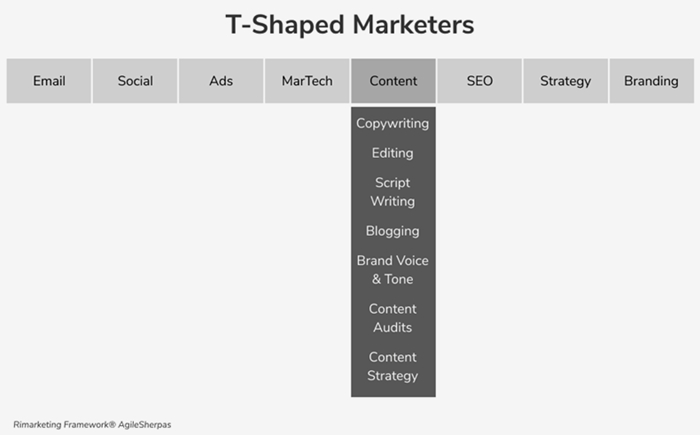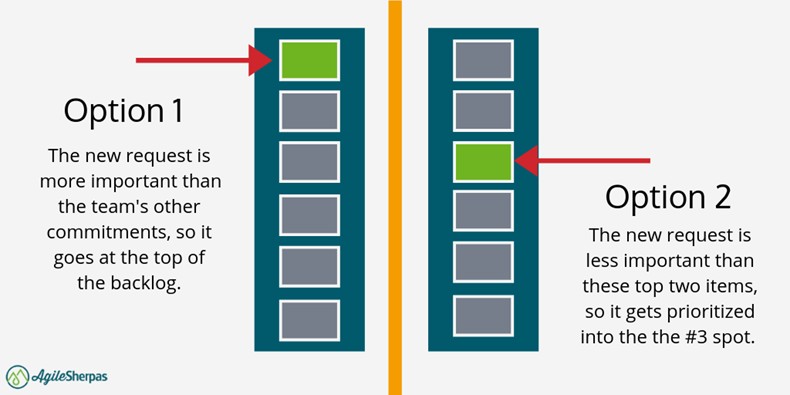As the buzz around Agile Marketing continues to grow, so do the number of questions marketers have about what it really means.
I recently hosted a webinar for MarketingProfs titled " Agile Marketing 201: Creating Persistent Teams." It generated so much awesome discussion that we ran out of time to answer all the inquiries that marketers had.
Fortunately, we have this supplementary forum available to continue the conversation!
Below you'll find answers to some major queries about Agile teams, leaders, and measurement, along with many other FAQs. Some questions have been edited slightly for context and clarity, and I've grouped similar ones together under the same heading so you can easily find your favorites.
Before we tackle those questions, I want to offer a quick recap of the webinar that spawned the questions (the free recording is available here):
- Marketers are enthusiastic about Agile (42% say they've already adopted it, and 42% of those who haven't say it's in their plans this year); but, when we try to apply it at the project level only, we risk catastrophe.
- Trying to be Agile part-time creates inevitable neglect around the Agile experiment, because our other projects and "day jobs" keep demanding our time.
- For best results, we want to find ways to build persistent Agile teams that have a clear, shared purpose (e.g., demand generation) measured by a few core KPIs (e.g., increase addressable audience or hit Marketing-qualified leads (MQL) targets).
- Those teams will be cross-functional, meaning they have all the skills needed to complete their queue of work.
- They should also have strong leaders who can help them push back on work that doesn't align with their goals and metrics, as well as prioritize the work they are going to do so they're always attacking the right thing at the right time.
- Bonus Agile points if you can design teams based on the customer in some way: e.g., stages of the customer journey.
- None of this has to happen overnight. By piloting one or two Agile teams (that are 100% dedicated to using Agile), you can experiment with the approach in a lower-risk way.
Who Makes Up an Agile Marketing Team?
Is each Agile team a unit within the organization that has its own vision, mission, core values?
No, not really. Each Agile team likely has its own working agreement that covers its unique incarnation of Agile, team expectations, and important behaviors, but it's still aligned with the organizational values, vision, and mission.
Different teams may have slightly different ways of holding standup, or different expectations about how they handle their visualized workflow, but they remain connected to the integral pieces of the company that predate, and are independent of, Agile ways of working.
Of course, we'd hope that company values already align with Agile ones. If that's not the case, Agile teams may need to lead the way in evolving those values.
With regard to Agile teams, who typically makes up the team? Leadership level all the way down through to associate level?
We often refer to Agile teams as Execution Teams to make it clear that they're the doers of work. Team members have skin in the game—they're a unit that's responsible for doing amazing work that serves their audience.
They do have a Team Lead who helps prioritize their backlog so they're doing the right work at the right time, but that person is typically a director-ish level.
Even in very small marketing organizations, you'd be unlikely to find a vice-president or CMO actually on an Agile team. They provide advice and guidance on prioritization, but they're not a team member.
How are the individuals for each team selected, persuaded to implement Agile, and then trained or supported?
During the early days of an Agile transformation, senior marketing leaders and Agile consultants likely put their heads together to identify the new team structures needed to support a customer-centric Agile marketing organization. That process determines what the future teams will look like and what their composition needs to be (demand generation needs more content people; everybody needs a strong analytics person, etc.).
Best-case scenario then is that all the Execution Team members get a strong introduction to Agile that includes an emphasis on what's in it for them. Agile is great for the organization, but its massively beneficial for individual marketers, too. When done well, this kind of foundational training gets almost everyone on board. Occasionally, there are holdouts; they may not stick around in the post-Agile world.
Once Agile is taking hold, the best-practice is to provide access to some kind of ongoing coaching support. That can be via an external group like AgileSherpas, my company, or the marketing organization can train or hire internal experts. But most marketers are new to Agile, so they'll make common (and avoidable) mistakes if they don't have guidance.
If you were building a team, what are the six roles you'd consider vital to an Agile team?
What a fun question this is! If I were building my own Agile Dream Team, I'd have the following:
- A fully dedicated Team Lead who's a strong leader, devoted to Agile, and politically savvy enough to push back on stakeholders on behalf of his/her team.
- A full-stack content creator who can create a wide variety of content independently while also supporting basic design tasks.
- A second creative type who's stronger in design and video but comfortable with basic written content, too.
- A technical person of some kind, maybe a marketing technology specialist, who can also provide support on metrics and measurement.
- A community and social media manager who could also oversee paid promotion and pitch in for measurement, as needed.
- A new associate who can be trained to support all the other team members in their various tasks.
You'll notice all my dream hires have multiple skills (also known as being T-shaped). Agile teams work best when team members are multi-faceted. We don't want a single point of failure for any of the team's key activities.

The team I lead currently is very content-centric, so that's also influencing my imaginary team's makeup. If this were a customer retention-focused team, the roles would be much different.
There's really no perfect composition for an Agile marketing team; its more about committed team members with sufficiently broad capabilities to support the team's goals.
Balancing Agility, Due Dates, and 'Day Jobs'
We've struggled to stand up cross-functional teams because the individuals aren't 100% dedicated to the Agile team. As a result, their "day job" tends to suck them out of the Agile team. Is there a secret to success?
If I'm being honest, the secret is not to try and be Agile part-time. Agile systems are designed to work for teams that spend all their time together working on a single backlog.
The most straightforward option in this scenario is to have the cross-functional team members bring all their "day job" work with them to their cross-functional team. That work goes in the backlog, and their Team Lead can then prioritize it against the rest of the teams work. That's the best way to make sure Agile teamwork doesn't get neglected in favor of "day job" activities.
We need it all visualized and prioritized together so the work that's really most important gets done.

Some of my marketing leaders prevent T-shaped marketing. Were also a very process-intensive organization. So my team is now 19 people and there's a lot of business-as-usual (BAU) process work that's being fit into the Agile board. Advice?
Whew. So many things to unpack in this question.
First, 19 is way too big for an Agile team. We want to keep them below 10 whenever possible. Splitting into two teams (maybe even three) will help people actually feel like a team and more like they can/should help their colleagues handle the smaller scope of work that's their team's responsibility. Smaller teams should also reduce the noise of too much BAU work cluttering a board, since now you'd have two (or three) boards instead of one.
You may also need to help these marketing leaders understand their role in an Agile environment. Often these folks have gotten where they are by being great at their original role, and they think they need to keep adding value by applying that expertise to individual pieces of work. Agile asks them to support the team as a unit rather than get their hands dirty with each and every project, and that can be a difficult transition.
Ultimately, it sounds like there are people issues that need to be tackled before your process can really work at its highest level. Coaching can help a ton here.
One team works on multiple projects—the same team?
Yes! As we talked about on the webinar, we want to flow projects to persistent Agile teams. So my demand generation team's backlog will include lots of different projects of different levels of importance (content upgrade creation, social media engagement, events, etc.) along with our recurring "keep the lights on" activities (this week's blog post, filing the social media sharing queue, etc.). We focus on the most important things, get them done, and then move on to the next ones.

I am struggling with trying to work in an Agile way (standups, kanban boards, etc.) AND promise my stakeholders their deliverable by their requested date. Is it possible to balance Agile work with hard-and-fast due dates?
It's totally possible. You'll simply use urgency as one of the factors you use to prioritize your backlog. Items with upcoming dates will be more likely to make their way to the top.
This works best when you're able to prioritize work with high business value alongside work with due dates. We want to make sure the Agile system is doing high-value work, not just delivering based on arbitrarily assigned dates.
Some of my clients have created formulas that help them incorporate urgency along with predicted bottom-line impact of particular work items. That approach can help make sure you're delivering work that makes an impact and you're not being a slave to the calendar.
How to Measure Agile Marketing Teams
In talking about KPIs for the marketing team, are you referring to marketing metrics or can we have a few examples?
Yes, the KPIs for an Agile marketing team would be marketing-specific and based on the team's core reason for being. So, if we have a "top of funnel" team, they've got KPIs like email subscribers, brand awareness/sentiment, website engagement, and conversion, etc.
These metrics will all be very specific to your marketing activities and goals, of course, so there aren't any "out of the box" marketing metrics that every Agile marketing team would use.
What about incorporating OKRs (objectives and key results) for alignment across the teams?
I love doing this; it's an excellent way to make sure daily activities are aligned with longer-term goals.
The Agile marketing teams I coach that responded best to COVID-19 were the ones who could still tie their COVID-19-related activities to OKRs. They could then be responsive—and agile—in the short term without totally losing sight of the big picture.
All you have to do to make this work is tag each work item or task with the OKR it ladders up to. Then you can easily get a visual indicator of how much time the team is spending on each OKR (and how much time they're spending on things that might not align with any larger goals).
What are some tracking tools for marketing backlogs and workload balancing in the Agile model?
My simplest go-to remains Trello. You can add people to Trello cards and then sort by team member to see their workload. There's tagging, estimation, checklists, etc. etc. in this easy-to-learn tool. It's a classic, but remains the easiest digital tool I've found for getting marketers up and running on Agile ASAP.
Other, more advanced, project management-style tools include Aprimo, Monday.com, and CoSchedule. You can also dive into the vast world of Agile-specific tools; in that realm I like LeanKit and Kanbanize.
Best-Practices for Agile Marketing Meetings
Do you have a "live" standup or an asynchronous standup? We have a lot of different schedules happening...
Live standup if at all possible. I totally understand the scheduling challenge, especially in the distributed world, but live standup is SO MUCH better than asynchronous.
The real power of this meeting is not the part where your teammates recite what they've been up to over the past 24 hours, but the opportunity for collaborating with them to make progress on the team's highest-value work. Doing that is much harder when we can't have a conversation.
I'd even say reduce the number of standups you have—three times a week instead of five, for example—rather than go to asynchronous.
Do the teams hold their own standup, or do the teams meet together?
Each Execution Team has its own individual standup. For larger organizations, though, you can have a second round of standups where Team Leads get together and share highlights from their teams. That's known as a scaled daily standup, or sometimes a Scrum of Scrums, and it allows individual team members to attend just one standup and get back to work while leaders escalate major issues or opportunities across the wider marketing organization very quickly.
Must-Haves for Agile Marketing Leadership
Is the Agile leader a middle manager or a CMO?
Usually somewhere in between. We like the Team Lead to have a good strategic perspective so they can ensure the Execution Team is doing the right work at the right time. They also need a relatively good understanding of the team's daily activities so they can tentatively commit to incoming work requests, or push back on things that aren't well-scoped or too large to tackle.
In reality, personality is more important than job title for this role. You need someone who can be a champion and protector of the team, who's not a micromanager, and who has the people skills needed to help the team navigate its journey into agility.
Sounds like each team needs a sponsor of sorts—someone committed to the success of the team, with authority to remove obstacles, and enough clout to get a following?
Totally right: that's the Team Lead that I've been referencing. The reference here to being "committed to the success of the team" is a big one. We don't want a project manager who's only concerned about their project, for instance; they'll have a hard time focusing on the team's larger KPIs.
The best Agile Team Leads provide strong "air cover" for their teams. They meet with stakeholders, gather requirements, say no to incoming requests that don't align with team goals, and generally free up the team to focus on doing amazing things. That's when the magic happens.
Are there times/organizations where an Agile team just won't work? For instance, I'm the leader of a four-person marketing team at a mortgage company and not sure if this would work?
I've never found a marketing team or organization that couldn't use some form of Agile to improve its processes. In your case (and most cases in marketing) it's unlikely to be pure Scrum, but a Kanban-style hybrid could be transformative for your team. My team at AgileSherpas is just four (and distributed worldwide), and we use Kanban to great effect.
What Did We Miss?
Still have more Q's? I've got A's! Comments are great, and you can reach me at andrea[at]agilesherpas[dot]com.




